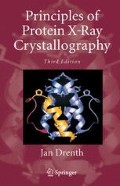Abstract
When a stationary crystal is illuminated with X-rays from a continuous range of wavelengths (polychromatic or “white” radiation), a Laue diffraction pattern is produced. The very first X-ray diffraction pictures of a crystal were in fact obtained in this way by Friedrich, Knipping, and Laue in 1912. However, since then, monochromatic beams were used nearly exclusively in X-ray crystal structure determinations. This is due to the fundamental problem that a single Laue diffraction spot can contain reflections from a set of parallel planes with different d/n, where d is the interplanar distance and n is an integer. These spots are multiples instead of singles. This is easily explained by Bragg’s law:
Access this chapter
Tax calculation will be finalised at checkout
Purchases are for personal use only
Preview
Unable to display preview. Download preview PDF.
Author information
Authors and Affiliations
Rights and permissions
Copyright information
© 2007 Springer
About this chapter
Cite this chapter
Drenth, J. (2007). Laue Diffraction. In: Principles of Protein X-Ray Crystallography. Springer, New York, NY. https://doi.org/10.1007/0-387-33746-6_12
Download citation
DOI: https://doi.org/10.1007/0-387-33746-6_12
Publisher Name: Springer, New York, NY
Print ISBN: 978-0-387-33334-2
Online ISBN: 978-0-387-33746-3
eBook Packages: Biomedical and Life SciencesBiomedical and Life Sciences (R0)

